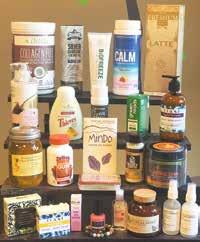
12 minute read
THE HEALTHY FOOD MOVEMENT
Pandemic Trends are Shaping Better Local Food Systems
by Marlaina Donato
Like so much else on the planet, the two-year coronavirus pandemic turned the health food world upside-down. “I found myself thinking real dystopian and wondering if people would be able to survive if grocery stores crumbled,” recalls Diana Mondragón, of Rockford, Illinois. “That scary thought train reminded me that I want to learn how to be more self-sustainable.” Her once-occasional drop-bys to farmers markets are now an essential weekly ritual. “I want to support local farmers and food producers to help communities grow stronger and healthier,” she says.
When the long supply chains of the conventional food system became disrupted, many Americans found themselves feeling insecure about food availability for the first time in their lives. The industrialized food system that had operated so efficiently for many generations had relied on long and complicated supply links; when they broke down or became gridlocked, the result was empty supermarket shelves and long waits for home deliveries. Add the economic repercussions and job losses, and about one in nine households lacked enough nutritious food to sustain a healthy life, report researchers from New York University.
Faced with the system’s shortcomings, a noteworthy outcome has been a surge in demand for healthier food production using sustainable and humane practices. Unable to drop by a nearby grocery store and get whatever they wanted whenever they wanted it, many consumers began buying locally grown produce for both practical and environmental reasons. After
two high-growth decades, farmers markets initially took a hit during pandemic closures, but they have since bounced back with renewed energy. A wide range of innovative solutions are being pursued by e-commerce entrepreneurs and food-equity advocates to get healthier local food into more hands and more neighborhoods.
Surging Concerns
Sales of natural and organic products in the U.S. grew by about 10 percent in 2020, the year of the COVID-19 outbreak, and by another 8 percent in 2021, reports SPINS, a Chicago-based data research firm, in Nutrition Business Journal. Sales growth in that sector was six to seven times larger than for conventional products, which experienced barely any sales growth at all.
Helping spur the trend, cheap food at supermarkets isn’t so cheap anymore, making organic food look better by comparison. The research company Data Weave reported in March that conventional food prices jumped by 11 percent in the previous 12 months of the pandemic, while prices for organic food increased by a relatively modest 2 to 4 percent.
The price pressures on conventional food “will continue to go up rapidly,” says Matt Tortora, co-founder of WhatsGood, a Rhode Island-based food e-commerce company. “The war between Russia and Ukraine is going to exacerbate that issue. And it seems like most of what’s going on in the world is going to affect our global supply chains even further, and in more profound ways than just our gas pump.”
Food-to-Table Creativity
The dominance of supermarkets and big-box stores in the years following World War II greatly diminished supply and demand of farm-fresh local food. A back-to-the-future trend that started taking hold a generation ago spurred a five-fold increase in the number of farmers markets across the nation, along with a proliferation of farms selling community supported agriculture subscriptions that delivered weekly batches of fresh produce to members. These increased sales enabled many small farmers to offset the body blow from business lost due to pandemic-related restaurant shutdowns; a number of them thrived, with record sales.
The signs for the 2022 outdoor market season have been encouraging. Green City Market, widely regarded as Chicago’s premier farmers market, reported more than 13,000 visitors in a six-hour span on May 7, even though the weather was still on the cool side and few spring crops were in season after a chilly and wet April.
At the same time, a previously little-used conduit for local health food sales—e-commerce—shows signs of spurring long-term growth. Some individual producers nimbly built out their web-based product sales by also providing home delivery, previously a rarity in the local food scene. For example, the e-commerce site Avrom Farm (Avrom Farm.com), of Ripon, Wisconsin, sells not only its own products, but also goods from other farmers, and Three Sisters Garden, of Kankakee, Illinois, which raises specialty vegetables, has converted entirely to e-commerce and home delivery.
Taking this concept to the next level is WhatsGood, which in 2014 began providing home delivery and pickup services for farmers markets in several cities. In the pandemic, the company became a lifeline to connect farmers with consumers at a time when stayat-home orders and social distancing concerns hampered or closed farmers markets.
Late last year, WhatsGood introduced a new business model that bypasses farmers markets to allow consumers to order goods online directly from farmers for home delivery. SourceWhatsGood.com now operates in 21 states. Tortora estimates that demand for local food is about 12 times greater than it was before the pandemic, even as supermarkets again start stocking more faraway-grown, conventional produce.
Even Better for the Planet
While the pandemic created a sense of ur-

GROW
YOUR BUSINESS
Secure your growing space!
Contact us today. 734-757-7929 gency about healthier eating, it also elevated concerns about the health of the living environment. An April 2022 study issued by New York University’s Stern Center for Sustainable Business found that products specifically marketed as sustainable had a 17 percent share of the market for consumer-packaged goods, up from 13.3 percent in 2015. Nearly half of all products introduced in 2021 touted sustainability benefits, up from 28 percent in 2017. Organic food sales in 2021 amounted to $51 billion; 30 years earlier, that market was estimated at a mere $1 billion, says the SPINS report.
Now there is growing support to take stewardship of the land to the next level through regenerative agriculture practices which focus on building and maintaining the health and biological vitality of the nation’s soils, and in some cases, means restoring soils stripped of their vitality by conventional farming practices. It has been most heavily promoted by the Rodale Institute, based in Emmaus, Pennsylvania, which has developed standards for a Regenerative Organic Certified food label.
The sustainability issue resonates deeply with people like Katlin Smith, founder and CEO of Chicago-based Simple Mills, a 10-year-old company that’s widely recognized as the preeminent natural baking mix brand nationally. “I started the company after seeing what a huge impact food has on all of our bodies, and I realized how much we had processed the heck out of our food. And it was really undermining people’s health,” she says.
In the last two years, the company has expanded its focus to work with farmers to improve soil health and biodiversity, and reduce greenhouse gas emissions. It recently joined forces with the frozen smoothie company Daily Harvest and gluten-free frozen pizza maker Capello’ s to advance regenerative soil practices in almond growing. “Regenerative agriculture is really just growing food in a way that leans into nature and builds a healthy ecosystem for all who are involved,” says Smith.
Supplying Underserved Communities
Local food communities around the country are also playing an increasingly dynamic role in addressing food equity, access and security issues. Less than a decade ago, fewer than half of all farmers markets nationwide accepted federal Supplemental Nutrition Assistance Program benefits for purchases. Today, backed by U.S. Department of Agriculture funding, most do, with many markets accepting state-backed debit cards. To further increase access to locally produced food for lower-income families, many states provide matching shopping funds up to a certain limit, as do programs run by nonprofit organizations such as California’s Market Match and Double Up Bucks, run by the Michigan Fair Food Network.
To get healthy produce to people that live in urban “food deserts”, nonprofits are pioneering creative approaches. The Urban Growers Collective operates eight farms on 11 acres of land on Chicago’s Southside that combine education, training and leadership development with the growth of organic crops, which are then driven in a “Fresh Moves” bus to local community and health centers, and churches. Founded by food justice advocates Laurell Sims and Erika Allen, the Collective worked with a coalition of nonprofits during the pandemic to deliver boxes of free food to households in underserved neighborhoods across the city. The pandemic “forced us to do some of the things we’d been talking about, but said we don’t have time yet. We just dived in,” Sims says.
The dramatic impact of the COVID-19 crisis drove up local interest in the Collective’s community gardens, with the number of volunteers jumping from 10 to 50. “It made a lot of people realize this ain’t no joke. People close to us were passing away,” says farm manager Malcolm Evans, who started volunteering for the Collective a decade ago as a teenager growing up in a nearby public housing project. “People wanted to really know how to grow food. We’ve been doing it for years, trying to bring this to folks’ attention. Everybody needs to understand food and know where it comes from.”
Bob Benenson is publisher and writer of Local Food Forum, a newsletter that covers all aspects of the local food community in the Chicago region. He can be contacted at Bob@LocalFood Forum.com.

Megan Blackwell

Beso Wellness CannabisInfused Products
Beso Wellness uses a cannabidiol (CBD)-based formula combined with black seed oil, sometimes containing frankincense and myrrh, herbs found in the Bible and the Koran. The combinations give people the relief they need without having to rely on drugs, opiates or other harmful, addictive substances.
Owner Megan Blackwell says, “As a massage therapist in Los Angeles, I work with numerous NFL, UFC and NBA professional athletes, performers and a lot of people with pain. I wanted to do something about it that hadn’t been done before. Having an understanding of cannabis and its reputation for healing over the centuries inspired me to make the formulas. I then used them on my clients with great, consistent results and the testimonials speak for themselves.”
Beso Wellness products are designed to address the pain and discomfort without getting people high. They are safe, natural and effective. “Some say they feel a sort of body high that is relaxing and stress relieving, but much different than using cannabis,” advises Blackwell. “I want to help millions of people, as well as represent and inspire more women to take advantage of the vast opportunities that are here for us. Women lead in so many fields; not only sports and entertainment, but everywhere! We can run companies and stand out in this industry, too.”
For more info, visit BesoWellness.com.



Earth-Friendly Hiking
Hiking in the great outdoors is undoubtedly one of the most enjoyable sports on Earth, especially in the summertime, when the weather is temperate and the sun shines upon us. Unfortunately, nature’s charm can quickly fade when we stumble upon empty beverage cans, plastic sandwich bags or even worse, somebody’s still-smoldering cigarette butt, which could so easily become the next uncontrollable wildfire.
As stewards of the environment (and kind human beings), it’s important that we hike responsibly, leaving no detritus behind, respecting wildlife and preserving the pristine setting for everyone to enjoy. Here are a few tips for treading lightly on the next hiking trip. Avoid overcrowded places. The most popular national parks and hiking trails have been hosting a record-breaking number of visitors lately, severely stressing the flora and fauna. Consider exploring less trafficked spots so that these areas can recover. Stay close to home. Choose a trail close by to cut down on travel-related carbon emissions. For most of us, a beautiful natural setting is usually a short walk or bike ride away. Use sustainable gear. Wear outdoor gear by eco-friendly brands that strive to lower the carbon footprint in their sourcing, manufacturing and shipping practices, such as Patagonia or Merrell. Don’t litter. Leave no trash on the trail, including biodegradable items or food scraps, which could negatively impact wildlife. Remember to bring a bag on the walk to carry all refuse home—score extra points for picking up items that someone else might have left behind. Pack responsibly. Limit waste by wrapping homemade snacks and beverages in reusable bags and containers. Bring bamboo utensils.
Bring a reusable water bottle. Single-use water bottles are out. Bring a lightweight, reusable bottle. For longer hikes near fresh water sources, invest in an on-thego water filter. Ditch chemical products. Use chemical-free sunscreens and insect repellents to keep toxins out of the environment. This is especially important when taking an outdoor swim.
Don’t take a souvenir. Resist the temptation to handle, move or take home items found on the trail. Rocks, shells, a handful of sand, pinecones, flowers—they’re all integral parts of the ecosystem, serving as food and habitat for wildlife.
Stick to the trail to avoid trampling plants or causing other unintentional damage. Don’t engage with the animals. Getting uncomfortably close to touch, photograph or feed wild animals is a big no-no.
$5.00 OFF Health Products!




Expires 7/31/22, one per customer, not valid on supplements. We create a Personalized Nutrition Program for you using whole-food supplements and dietary changes to help avoid medications and surgery!
We Help With……..

Anxiety Fertility Thyroid Allergies Weight-Loss Headaches Fatigue Hormones Cholesterol Digestion Immune Issues + Many More!!!
Contact us at 734-470-6766 Mention this ad to receive $50 OFF your New Patient Evaluation!
Dr. Shannon Roznay D.C. is a Nutrition Response Testing™ Master Instructor and uses Activator Methods Chiropractic. Follow us at youtube.com/thrivewellnesscenter and facebook.com/thrivewellnesscenter.mi for free health tips, video seminars, sales and recipes!
We also carry healthy products to support good health! Save $5 with the attached coupon. We’re Thriving! Are You?





